Editor of this issue: Antanas Klimas
Copyright © 1981 LITUANUS Foundation, Inc.

|
LITUANUS
LITHUANIAN QUARTERLY JOURNAL OF ARTS AND SCIENCES
Volume 27, No. 1 - Spring 1981
Editor of this issue: Antanas Klimas ISSN 0024-5089
Copyright © 1981 LITUANUS Foundation, Inc. |

|
A CASE GRAMMAR ANALYSIS OF THE LITHUANIAN PREDICATE NOMINAL 1
CHIEN-CHING MO
National Chengchi University
1. Survey of Some Previous PN Analyses
The following sentences taken from L. Dambriūnas, et al. (1972) are related to the analysis of predicate nominals:
(1) Mano tėvas yra mokytojas. (p. 21)
'My father is a teacher.'
(2) Vilnius tapo didžiausiu ir gražiausiu Lietuvos miestu.
(p. 215)
'Vilnius became the largest and the most beautiful city of Lithuania.'
(3) Šis miestas vadinasi Vilnius, (p. 43)
'This city is called Vilnius.'
Previous PN analyses can be roughly divided into three groups according to whether they
a. postulate different case roles for subject and PN;
b. allow more than one instance of a given case in a simple sentence; or
c. establish the PN as the deep-structure predicate.
In this section, I will give a brief synopsis of each of these methods.
(a) different cases
Charles Fillmore (1968:84) suggests an Essive case whose use is restricted to copulas. Langendoen (1970:102) assigns the Essive label to the subject nominal and calls the predicate nominal Predicate. Robert DiPietro (1971:90), extending Fillmore's notion of Dative to include the situation in which beings or objects are affected by the addition of semantic elements, presents an analysis which makes my father Dative and a teacher Object in sentence (1). Tang (1972:88) gives the name Essive to the predicate noun phrase and refers to the subject noun phrase with the case categories already available in the grammar. Stockwell, et al. (1973:29), although not case grammarians, assign the Finno-Ugric term Essive to the predicate nominal, not to the subject. Teng (1975:44) analyzes be as a relational state verb, my father as a Patient who is in the state of being identified in terms of Range, a teacher. In short, this idea of creating an entirely new case such as the Essive just for PN analysis is suspect solely on grounds of simplicity. It seems more economical to attempt to analyze Predicate nominals within a framework already available for the analysis of verbal and adjectival predicates than to introduce an ad hoc case relation into the system.
(b) same case
Nilsen (1973:25) analyzes
(4) John is a lackey.
(5) A hammer is an important tool.
as containing two Objects (John, lackey), and two Instruments (hammer, tool) respectively. Evidently, the assignment of the same case label to both subject nominal and predicate nominal deviates from Fillmore's one-instance-per-clause principle (i.e. a simple sentence can contain at most only one occurrence of any case). However, Nilsen (1973:25-26) comments that
there is little logical support for the position that there can be only one instance of a particular case per simple predication. One example of a violation of this principle is the equational or linking sentence . . . The concept of Predicate Nominative is a concept of surface structure. It is therefore difficult to see how a deep case label (Essive) can be assigned to a surface phenomenon. On the other hand, if it is argued that Essive is not a deep case, then we must assign the correct deep case label, and we are back to having more than one instance of a particular deep case in a simple sentence.
The same reasoning applies equally well to (1), although in the system used in this paper the designation stative Object (Os) is used here instead of simply Object.
(1) Mano tėvas yra mokytojas.
Os
Os
(c) PN as deep structure predicate
Chafe (1970:202) treats predicate nominals as state verbs whose basic structure is BE + N + Predicativizer. Thus, his analysis of sentence (1) can be shown below:
|
______________________________ |
|
|
| |
| |
The verb in (1) is identified as mokytojas. Clearly, the copula is not considered as a part of the verb. Be is seen as merely a carrier of tense and other inflectional units of verbs whose surface structure form is incapable of being inflected as other types of verbs in the English language (Chafe 1970:160). This interpretation seems to neglect the fact that a predicate nominal construction is involved in (1). Apart from this, Chafe does not postulate a scheme for handling predicate nominal constructions which are not stative such as sentences (2) and (3).
2. Semantic Import Projected from Semantic Functions
In discussing semantic sentence-types in Lithuanian and English, Valeika (1975:60-61) proposes the terms Essive and Translative for sentences (6) and (7) respectively, but gives no explanation of his proposal.
(6) Žmogus yra žinduolis.
'Man is a mammal.'
(7) Jonas yra inžinierius.
'John is an engineer.'
In fact, Stockwell (1977:18) remarks:
The copula be can stipulate three possible kinds of relationships between nouns A and B: (1) A and B referring to the same individual (A=B : e.g. My favorite pet is that cat.); (2) A belonging to the class B (A c B : e.g. The professor is a Rotarian.); (3) all members of A included among the members of B (A c B : e.g. Horses are animals.)
In English predicate nominal constructions, Bach (1967:476-477) states that from a semantic point of view, the contribution of the verb be to the meaning of a sentence is determined completely by the items that it links. Tang (1972:89) extends the notion of the Essive, whose semantic function in the Chinese predicate nominal is simply that of identifying or qualifying the party designated by the subject NP, so that it may be associated with what are called by Chao (1968:711-716) "classificatory verbs," as exemplified in (8)-(11).
(8) Wo jiao Xiao Ming.
'I am called Little Ming.'
(9) Ta xing Li.
'His (family) name is Li.'
(10) Ta xia-ge yue yao zuo xinniang.
'She will become a bride next month.'
(11) Ni hen xiang ni muqin.
'You look like your mother (very much).'
Teng (1976) defines the Chinese nominal predicate in copula sentences as assuming (at least) two different functions, either to identify or to characterize the subject NP. He further states that identification specifies the equation relationship between the two NP's, whereas characterization specifies the class-membership, that is, the subject NP is a member of the class characterized by the post-copula NP.
On the basis of English and Chinese PN analyses, I assume that every Lithuanian PN construction: NP + COPULA + NP 2 has one of the following semantic functions: Class Membership, Identification, or Similarity. The corpus used in this study is taken mainly from Introduction to Modern Lithuanian by Dambriūnas, Klimas and Schmalstieg (1972). Here are some examples from Dambriūnas, et at. classified according to the semantic functions of the verb būti 'be'.
(12) Mano mama yra šeimininkė. (p. 25)
'My mother is a housewife.'
(Class Membership)
(13) Didžiausias Lietuvos miestas yra Vilnius, (p. 83)
'The largest city of Lithuania is Vilnius.'
(Identification)
(14) Jis yra panašus į savo tėvą. (p. 297)
'He is similar to his father. (He looks like his father.)
(Similarity)
In Class Membership sentences, the PN (šeimininkė) places the subject (mano mama) in a general class. In identification sentences, the NP (Vilnius) establishes the identity of the subject (didžiausias Lietuvos miestas), while the function of similarity sentences is to set up some sort of comparison between the subject (jis) and the PN (savo tėvą). Besides, each of the PN constructions in this group has a predicate with two (+stative) Objects in its case frame.
3. Basic PN Construction
3.1 +[Os,Os]
In this case frame, the basic state verb is typically a copula verb (e.g. būti 'be') which functions as the link of the sentence subject and the predicate nominal. It needs two nominal elements with the Object case. One of them is assigned to serve as the sentence subject; the other is assigned as predicate nominal. In other words, the two nominal elements governed by the copula būti (or other suitable copula) are classified as [+stative] Object nouns, noun phrases, or clauses; neither of them initiates an action, is affected by an action or undergoes a change of state, experiences a psychological event, or owns, loses or acquires an Object.
The occurrence of the copula būti is always predictable in Lithuanian PN constructions. In this respect, Dambriūnas, et al. (1972:52) remark:
Present tense forms of the verb būti 'to be' may be
omitted; a dash may be written between two nouns:
Mano tėvas mokytojas.
"My father is a teacher.'
One may also say, however, Mano tėvas yra mokytojas. Both sentence types can be
used, but the sentence without the verb is a little less formal and more familiar.
Cook (1972a:47) assumes that semantic structures are deep structures. That is, Cook, if I understand him correctly, is of the opinion that as long as the copula be is semantically empty, it cannot exist at the level of deep structure. As mentioned before, in its copulative use, the meaning of be, which is derived from its semantic function, seems weak and insignificant. Its omission may be regarded as an exception only prevailing in informal but familiar spoken language. More recently, empirical evidence has been uncovered pointing to the semantic emptiness of the English copula. A good example is Schnitzer (1974), which reports that a copula-insertion rule is supported by findings in aphasiology. Therefore, I follow Bach (1967) in analyzing the copula būti as not being present in the base but being inserted transformationally.
According to the semantic functions of the verb būti 'be', the corpus sentences assigned to the +[Os,Os] frame can be divided into three major groups: (1) Class Membership; (2) Identification; and (3) Similarity.
3.1.1. Class Membership
Sentences like (15a-b), usually asymmetric, have a PN which is general in meaning and a subject which is more specific. The PN refers to a class to which the subject belongs.
|
(15) a. Dr. Viktus yra gydytojas. |
|
|
Os |
Os |
|
'Dr. Viktus is a physician.' |
|
|
b. Mes esame studentai. |
|
|
Os |
Os |
|
'We are students.' |
|
Before we proceed further, I would now like to set up a deep structure ordering principle which regards būti as an operator copying the features of the predicate NP onto the subject NP. This principle can be formalized as follows:
Any two noun phrases connected by būti are ordered in deep structure such that the noun phrase with the greater feature length precedes the noun phrase with the shorter feature length.
An example is
|
(16) Motina yra moteris. (A) Motina būti moteris. |
|
|
F |
+human |
becomes
|
(B) Motina būti moteris. |
|
|
F |
+human |
Here F represents any features which the listener may have been aware of before hearing sentence (16). (16B) representes his knowledge of motina after hearing sentence (16). After feature copying by the hearer has taken place, the number of features affixed to the subject is generally greater than the number of features affixed to the predicate NP. In (16B) F representes those features of motina which distinguish it from moteris. This same generalization applies in non-generic cases:
(17) Ši gydytoja yra moteris. Ši gydytoja būti moteris. |
|
|
F |
+human |
The feature -male is not inherent in the lexical entry for gydytoja 'doctor', but the būti statement copies it onto the feature complex of the NP ši gydytoja 'this doctor', thereby making the subject NP more complex. F in (17) represents those features which distinguish ši gydytoja from moteris. A more accurate representation of copying is
|
(18) Ši gydytoja būti moteris. |
|
|
H |
+human |
where H includes all the features of moteris except male, and so the feature length of the subject in (18) is greater than that of the predicate NP.
In the sentence with a generic subject, as in (19a), the PN does not specify the class to which an individual or a fixed group belongs, but instead delimits an entire class. A violation of deep structure ordering appears as semantically anomalous.
(19) a. Šunys yra žinduoliai.
'Dogs are mammals.'
b. ?Žinduoliai yra šunys.
'Mammals are dogs.'
The deep structure ordering principle can account for the fact that in class membership sentences the subject NP, either generic or non-generic, is more specific than the predicate NP. Under this analysis, the deep semantic structure of (15a) would look something like (20).
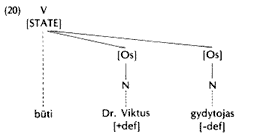
(20) incorporates an additional designator to show that Dr. Vitkus is definite, while gydytojas 'a physician' the class indicator is not definite.3 The inversion of the order of these nominal elements will often result in a semantic anomaly (cf. Anderson, 1971:206).
(21) a. ?Gydytojas yra Dr. Vitkus.
'?A physician is Dr. Vitkus.'
b. ?Studentai esame mes.
'?Students are we.'
The deviance of (21) illustrates the sentence's asymmetric nature. Besides, that the PNs in this group are broad in scope is underscored by their usually being preceded by the 0 determiner in the singular and by the plural ending such as -ai when they are plural. Sentence (15a) illustrates the former instance; sentence (15b) the latter. Sentence (22) deviates from (20) by marking the second stative Object (i.e. the PN) as definite, rather than indefinite. I therefore consider Lithuanian equivalents like (22) to be ungrammatical in spite of the fact that Chafe (1970:202) handles (22) as if it were perfectly acceptable.
(22) An ouzel is the bird.
Another example which actually appears in the corpus is (23).
(23) Lietuvių kalba yra graži kalba. (p. 41)
Os
Os
'Lithuanian is a beautiful language.'
(Lit.: Lithuanian language is beautiful language.)
In (23) the noun assigned to the first stative Object is the same as that assigned to the second (kalba 'language'). That is, the same noun underlies both subject and PN. The PN in (23) functions as a class delimiter. Unlike (21), it does not specify the basic class to which the subject belongs, since the subject already contains that information.
3.1.2. Identification
In the second major subcategory of the +[Os,Os] frame, the PN in copula sentences identifies the subject NP, instead of classifying it. Identification sentences differ from class-membership sentences in several significant ways. The first of these is that the subjects of identification sentences are basically equivalent to the PNs.4 Therefore, identification sentences are equational and, by extension, symmetric (e.g. (24) if reversing the order of the noun phrases assigned to the two Objects does not alter the sentence's meaning but affects the sentence's thematic meaning.5
(24) a. Nemunas yra ilgiausia Lietuvos upė. (p. 113)
Os
Os
'The Nemunas is the longest river in Lithuania.'
b. Ilgiausia Lietuvos upė yra Nemunas.
Os Os
'The longest river in Lithuania is the Nemunas.'
On the contrary, class-membership sentences are unreversible since there are other possibilities to satisfy other members in the same class identified by the PNs. Besides, Seuren (1969:203) points out another major difference:
There is a regular difference, in English, in the meaning of be according to whether it is followed by a definite or an indefinite noun phrase. If the noun phrase is definite, be establishes an equivalence relation. But if it is indefinite, be establishes a relation of inclusion within a class.
That is, the PN is usually definite in identification sentences but indefinite in class-membership sentences. Teng (1976) uses the different question type as a criterion for distinguishing these two subgroups within the +[Os,Os] frame. He assumes that questions corresponding to the English who-type are appropriate only for identification sentences, as in (25); what-type for class-membership sentences only, as in (26).
(25) a. Who is the former president?
b. The former president is Ford.
(26) a. What kind of person is the former president?
b. The former president is a Republican.
Under this analysis, the relevant semantic structure of (24a) can be diagrammed as follows:
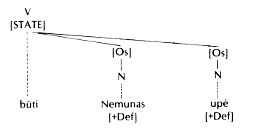
The corpus also contains the following sentences classified under the heading of identification:
(27) Klaipėda yra Lietuvos uostas prie Baltijos jūros. (p. 83)
Os
Os
'Klaipeda is Lithuania's harbor on the Baltic Sea.'
(28) Tai yra minkščiausias obuolys.6 (p.
219)
Os
Os
'That is the softest apple.'
(29) Mindaugas yra pirmasis suvienytos Lietuvos karalius.
Os
Os
'Mindaugas is the first king of united Lithuania.' (p 281)
Unlike the PN in the class-membership sentence which can occur with the 0 determiner in the singular (e.g. (15a)) or alone in the plural (e.g. (15b)), the PN in the identification sentence is often preceded by a possessive form of a noun such as Lietuvos 'Lithuania's' (27), a superlative form of an adjective such as minkščiausias 'softest' (28) or an ordinal number such as pirmasis 'first' (29).
3.1.3. Similarity
The function of similarity sentences like (30) and (31) is to establish some kind of comparison between the subject and the predicate nominal. Interchanging the order of the subject and the predicate nominal does not alter the sentence's meaning in any way other than thematically.
(30) a. Šis yra panašus į tą.
Os
Os
'This is similar to that.'
b. Tas yra panašus į šj.
Os
Os
'That is similar to this.'
(31) Šis yra nepanašus į tą.
Os
Os
'This is different from that.'
32) *Jonas yra panašus j save.
'*John is similar to himself.'
To explain the ungrammaticality of sentences such as (32), Postal (1971:186) proposes the S-O constraint in sentences with the surface verb similar as follows:

Sentence (32) does not have the possibility of being coreferents. That is, it manifests a coreference constraint. Besides, McCawley (1963:150) states that the semantic representation of similar contains not an individual variable but a set variable. This accounts for the ungrammaticality and grammaticality of (33) and (34) respectively and shows why (35) a paraphrase of John is similar to Peter can not be regarded as having a conjunction of sentences as its deep structure, as in (36).
(33) *Jonas yra panašus.
'*John is similar.'
(34) Tie žmonės yra panašūs.
'Those men are similar (to each other).'
35) Jonas ir Petras yra panašūs.
'John and Peter are similar.'
(36) *Jonas yra panašus ir Petras yra panašus.
'John is similar and Peter is similar.'
Lakoff and Peters (1966) propose that sentence (35) has as deep structure a simple sentence with a conjoined subject as in (37):
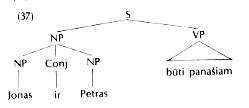
They state that the sentence Jonas yra panašus į Petrą arises from the same deep structure as (37) through the application of a 'conjunct movement' transformation which optionally shifts one of the conjuncts of a conjoined subject into the verb phrase. On the basis of the facts presented above, I would like to conclude that a different extralinguistic referent is required for each of the noun phrases assigned one of the frame's Os case roles.
3.2 +[O,0]
In this case frame, the first nominal element with the Object case is assigned to the subject of the sentence representing the person or thing which undergoes the change; the second nominal element serves as the predicate nominal which specifies the result. In Lithuanian, such verbs as tapti 'become' virsti 'turn into, become' occur in this case frame.
(38) Ūkininkas tapo karaliumi. (p. 176)
'The farmer became a king.'
(39) Broliai pavirto juodvarniais. (p. 176)
'The brothers turned into ravens.'
We follow Chafe (1970) in treating tapti and virsti as the result of applying the inchoative derivation to Ūkininkas yra karaliumi. The validity of this analysis diagrams the deep structure of (38) as follows:
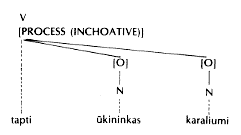
Note that traditional grammarians usually put the predicate nominal governed by basic state verbs or process verbs under the heading 'subjective complement'.
3.3 +[A,O,O]
The domain of the +[A,O,O] case frame is called 'objective complement' constructions by traditional grammarians. All sentences with this frame have semantically complex action-process verbs. The Agent here is to say something or bring something about; what is said or effected is that the first nominal element with the Object case in the frame is the second nominal element i.e. 'O be O' (cf. Cook, 1973a:72). Chafe's derivational units can be used to account for the deep structure of +[A,O,O] sentences. Verbs like paskirti 'name', 'appoint', išrinkti 'elect', vadinti 'call', išsirinkti 'choose' can be viewed as derived state verbs, formed from basic action-process verbs to which both the deactivative and resultative derivations have been applied.
Below are some examples:
(40) Jie paskyrė Joną mokytoju. (p. 175)
They appointed John a teacher.'
41) Mes išrinkome jį atstovu. (p. 176)
'We elected him a representative.'
42) Studentai vadina jį tinginiu. (p. 175)
'The students call him a lazybone.'
43) Jie išsirinko Joną prezidentu.
'They chose John as their president.'
(40), for example, can be roughly derived from (44) and (45).
(44)
|
Jonas tapo mokytoju. |
V |
(45)
|
Jonas buvo mokytojas. |
V |
The deactivative derivational unit deletes the Agent from the case frame. Adding resultative turns an already process sentence into a stative sentence (cf. (45)). If this analysis is correct, for (40) I will posit that it has an underlying structure like (46).
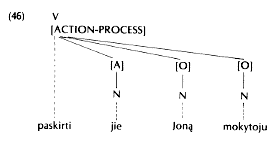
4. Epilogue
Very little material is presently available in Lithuanian within the framework of case grammar. An attempt has. been made to describe accurately the data available to me, but I make no claim that the analysis offered here is in any way complete. As more data are available, this analysis will have to be altered although I hope that the basic assumptions are correct. The +[Os,Os] frame, for example, is divided into three mutually exclusive subgroups (Class Membership, Identification, and Similarity), each with its own set of well-defined criteria. The breakdown suggested for the Class Membership and Identification categories, however, is only a guideline, since each of these two subgroups must contain some sentences which have two readings.7
Finally I must confess that I come here to praise case grammar and to 'bury' it as a cornerstone for Lithuanian linguistics by analyzing Lithuanian predicate nominals. Besides, I hope that future research will present a better understanding of PN constructions in Lithuanian and in general.
BIBLIOGRAPHY
Anderson, John M. 1971. The Grammar of Case: Toward a
Localistic Theory.Cambridge Studies in Linguistics, number 4, Cambridge: Cambridge
University Press.
Bach, Emmon. 1967. "Have and Be in English Syntax," Language 43:
462-85.
Bloomfield, Leonard. 1933. Language New York: Henry Holt and Co.
Chafe, Wallace L. 1970. Meaning and the Structure of Language. Chicago: The
University of Chicago Press.
Chao, Yuen R. 1968. A Grammar of Spoken Chinese. Berkeley and Los Angeles:
University of California Press.
Cook, Walter A., S.J. 1972a. "A Set of Postulates for Case Grammar Analysis," Languages
and Linguistics: No. 4:35-49.
" " . 1972 b. "A Case Grammar Matriz," Languages and
Linguistics: Working Papers, No. 6:15-47.
. 1973a. "Covert Case Roles," Languages and Linguistics: Working
Papers, No. 7:52-81.
" " . 1973b. "Role Structures in Content Analysis," in Meaning; a
common ground of linguistics and literature. 179-187. Edited by Don L.F. Nilsen. Cedar
Falls: University of Northern Iowa.
Dambriūnas, Leonardas, Antanas Klimas and William H. Schmalstieg. 1972. Introduction
to Modern Lithuanian. New York: Brooklyn, Franciscan Fathers Press.
DiPietro, Robert J. 1971. Language Structures in Contrast. Washington, D.C.:
Newbury House Publishers, Inc.
Fillmore, Charles J. 1968. "The Case for Case," in Universals in Linguistic
Theory, Ed. by Emmon Bach and Robert Harms. New York: Holt, Rinehart and
Winston.
Lakoff and Stanley Peters. 1966. "Phrasal Conjunction and Symmetric Predicates."
The Computation Laboratory of Harvard University Mathematical Linguistics and Automatic
Translation, Report No. NSF-17.
Langendoen, D. Terence. 1970. Essentials of English Grammar. New York: Holt,
Rinehart and Winston.
McCawley, James D. 1968. "The Role of Semantics in a Grammar." In: Universals
in Linguistic Theory. Edited by Emmon Bach and Robert T. Harms. New York, Holt,
Rinehart, and Winston, Inc. 124-169.
Nilsen, Don L. F. 1973. The Instrumental Case in English. The Hague:
Mouton.
Postal, Paul M. 1971. "On the Surface Verb 'Remind' ". In: Studies in Linguistic
Semantics. Edited by C. J. Fillmore and D. T. Langendoen, New York: Holt, Rinehart and
Winston, Inc.
Schnitzer, Marc. 1974. "Aphasiological Evidence for Five Linguistic Hypotheses,"
Language 50:300-15.
Seuren, Peter. 1969. Operators and Nucleus: A Contribution to the Theory of
Grammar. Cambridge: Cambridge University Press.
Stockwell, Robert, Scharhter, Paul. & Partree, Barbara. 1973. Major Syntactic
Structure of English. New York: Holt, Rinehart & Winston, Inc.
" ". 1977. Foundations of Syntactic Theory. Englewood Cliffs, New
Jersey: Prentice-Hall, Inc.
Tang, Ting-chi. 1972. Movement Transformations in Chinese Syntax. Ph.D.
dissertation, University of Texas at Austin.
Teng, Shou-hsin. 1975. A Semantic Study of Transitivity Relations in Chinese. Berkeley
and Los Angeles: University of California Press.
" ". 1976. "On Copula Sentence," Unpublished paper, Amherst:
University of Massachusetts.
Valeika, L. 1975. "Semantic Sentence-types in Lithuanian and English," Kalbotyra
xxvi (3): 51-63.
1 I am greatly indebted to Professor Antanas Klimas of the
University of Rochester for his valuable comments on an earlier version of this paper.
Research presented in this paper was supported by a grant made available by the National
Science Council, Republic of China.
2 In objective complement constructions (e.g. Jie išrinko jj prezidentu 'They elected him
president.'), the copula is deleted in surface structure.
3 There are no articles before nouns in Lithuanian. Thus, gydytojas can mean:
physician, the physician, a physician. We must specify the semantic feature |+definite|
for certain nouns; otherwise there will be no way to account for the semantic anomaly of
(21.a) and the ungrammaticality of the following sentence:
"Tikejimas priklauso Jonui.
'*Faith belongs to John.'
(cf. Jonas turi tikėjimą.
'John has faith.')
4 It is quite questionable that the copula verb in identification sentences carries the
same function as the mathematical equation (e.g. Two plus two is four.), since there are
other possibilities to satisfy the equation.
5 Word order and emphasis are directly involved in the expression of thematic
meaning (cf. Chafe 1970:210-233). Even though the identification sentence can be inverted,
the inverted sentence may carry a slight difference in conotation. Thus, e.g., sentence
(24.a) implies a presupposition of a river called Nemunas, while in sentence (24.b)
the Nemunas is a piece of new information.
6 Sentence (28) is a deictic example from the corpus. This type of identification, derived
from the Greek verb show, is what Bloomfield (1933:140) termed demonstration. Inversion
will result in awkwardness if the original subject is a deictic word. Therefore,
reversibility of the two NP's in (28) is rather constrained especially so in Lithuanian.
7 Klimas (personal communication) provides the following example:
Jimmy Carteris yra
Jungtinių Valstybių prezidentas.
'Jimmy Carter is the
President of the U.S.'
and states that as an identification sentence, it identifies the two referents, Carter and
the President, but as a class-membership sentence, it merely defines the role Carter plays
in the government; hence the President is non-referring.